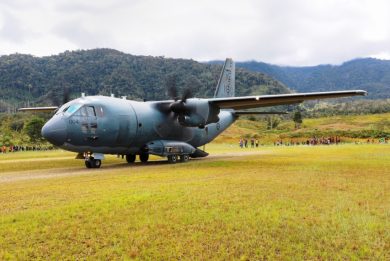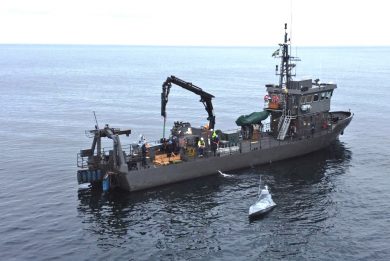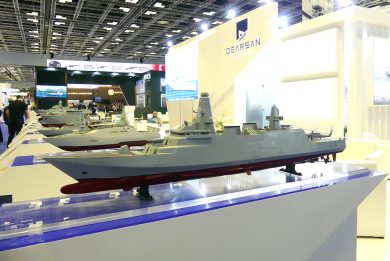
Decimomannu International Flight Training School, the industry view
To view the whole series of articles about the International Flight Training School, please click HERE
Activated in July 2022 on the Decimomannu Air Force Base in Sardinia, the International Flight Training School sees industry fully involved in the school activities, as it is providing all support to flight and training activities, the latter being the responsibility of the Italian Air Force

“The IFTS is formally an Italian Air Force school, it is an Air Force flight squadron powered by Leonardo,” Giuseppe Recchia, SVP IFTS at Leonardo, tells EDR On-Line. “The Air Force defines the training syllabus, selects the instructors and trains them, and is responsible for the training, while industry is responsible for all the services related to flight activities, simulation, as well as all other services linked to the campus activities.” By outsourcing all logistics, the Air Force managed to double its training capacity compared to what it was at Lecce-Galatina, where the 61st Wing is based. “Economic resources deriving from the sale of the courses cover Italian Air Force pilots training costs. As for Leonardo’s, the IFTS allows to strengthen the company position in the integrated training services business,” Giuseppe Recchia points out. Compared to other nations, where the whole training package has been outsourced to industry, the model adopted for the IFTS seems to be quite attractive. The IFTS model copes with Leonardo industrial plan, which includes the evolution from the typical OEM model, which is aircraft or solution supplier, to a service provider perspective, EDR On-Line was told.

Until now Leonardo has sold 122 M-346 worldwide (plus four owned by the company and assigned to the IFTS), both in the training and armed versions. The user with the greatest number of aircraft is Israel with 30 M-346, followed by Italy (18), Poland (16), Singapore (12), Greece (10), and Qatar (6). Leonardo does not comment on other two customers, Nigeria, which ordered 24 M-346FA, the fighter attack configuration, and Turkmenistan, which ordered four aircraft in the same version and two in the trainer version, this information being however of public domain. Overall, the M-346 have totalled more than 830,000 flight hours. Beside the aircraft, Leonardo also provided customers with 21 Ground Based Training System kits.

Austria should be the next M-346 customer; Austrian pilots are following the course at the IFST, and recently a government-to-government agreement between Austria and Italy finalised the acquisition of 12 M-346FA [1]. Among nations who fly their own M-346, the only one which is sending pilots to the IFTS is Singapore, its Air Force operating its trainers on the Cazaux Air Base in France. “Ten countries which pilots follow their Phase 4 course at Decimomannu do not have the M-346 in their air forces, so obviously for us at Leonardo the IFTS is a driving for future sales,” Giuseppe Recchia underlines.

An increasing international presence
Pilots from 10 nations, Austria, Canada, Germany, Hungary, Japan, Qatar, Saudi Arabia, Singapore, Spain, and the United Kingdom, are currently flying at Decimomannu; with the exception of Hungary and Spain, all other nations had already pilots graduated from the IFTS, while the Magyar Légierő and the Ejército del Aire y del Espacio will soon, for the first time, get their pilots trained at Decimomannu. As for the Netherlands and Sweden, both nations have already signed their participation, and their student pilots will soon joint those of the other nations on the Sardinian base.
Considering that pilots trained at the IFTS will then go to fly different aircraft, Eurofighter Typhoon, F-15s, F-16s, F/A-18, F-35s, Gripen, Mirage 2000, Rafale, and Tornado, it is difficult to have exact figures on how much the IFTS syllabus allows customers to save in the segment between the end of Phase 3 and the Combat Ready status, which involve Phase 4 and OCU, these aircraft being quite different between them, an average figure being 30%.
Other nations might soon join the IFTS. At the Military Flight Training Conference organised by Defence iQ, which took place on 31 March – 2 April in Sardinia, Lt.Gen. Brian Robinson, Commander Air Education and Training Command, USAF, announced that the United States Air Force will soon send its pilots to Decimomannu to follow Phase 4 training, probably until the USAF training system based on the Boeing/Saab T-7A will not become operational.

A growing training capacity
Currently the school can hosts nearly 60 student pilots at the same time and has an output of 80 trained pilots per year. The increased accommodation capacity, up to 100 apartments, and the increased number of aircraft, the Italian Air Force contract for a second batch of M-346 includes aircraft for the Frecce Tricolori aerobatic team as well as five extra M-346 destined to the IFTS, will boost this number. With the increased hosting capacity, the Decimomannu school aims at an output of 100 trained pilots per year, EDR On-Line understanding that this is quite probably just a first step.
The market potential is there: “We consider that in accessible countries worldwide the need is for 2,000-2,200 trained pilots per year,” Giuseppe Recchia says, so even considering that this estimate includes the USAF, which soon or late will become autonomous, the numbers are sufficient to guarantee full steam work to the IFTS, which since it started operations at Decimomannu in July 2022 qualified 140 pilots, 70% of them being foreign students. The 200 mark is approaching, as around 60 pilots were undergoing the course when EDR On-Line visited the IFTS in late May. And to answer future market requirements a further increase in the use of simulation is being considered.
An intense flight and maintenance activity
Every working day at Decimomannu the IFTS aircraft fly between 30 and 35 sorties, flight activity being favoured by the climate, as in southern Sardinia weather is mostly clear, therefore the number of missions cancelled due to bad meteorological conditions are very few. The build-up of flight activities since the start of operations at Decimomannu is very similar to that of the simulators. Since July 2022, some 20,000 flight hours have been logged by the IFTS T-346A, with 2,200 hours in 2022, 5,300 in 2023, 6,035 in 2024, and nearly 6,500 in the first five months of 2025. This means an average of 250 hours per aircraft in five months.

Such a high rate must be supported by an appropriate logistic system that ensures maximum availability. A key step for Leonardo was the achievement of the AMO (Approved Maintenance Organization) qualification in July 2024, followed in April 2025 by the CAMO (Continuing Airworthiness Management Organisation) certification. “We have also been the first entity in Europe to obtain the EMAR 145 (European Military Airworthiness Requirement) certification,” the AJT responsible for aircraft maintenance at Decimomannu told EDR On-Line.
The maintenance hangar has eight spots where aircraft can be recovered for different levels of maintenance. This ranges from real time interventions, in case of failures during a flight, to 100 hours inspections, 500 hours inspections, and 2 years and 6 years phased inspections.
Experience on the T-346A is increasing with time, as well as data collected, and this together with the presence of a HUMS (Health & Usage Monitoring System) that allows predictive maintenance ensures high availability. According to information provided by the company, aircraft efficiency is around 70%, the availability of buffer aircraft ensuring that 95% of scheduled sorties are flown.

On average, six aircraft are recovered at any time in the maintenance hangar. The experience acquired by maintainers will quite probably bring to an increase from 100 to 150 flight hours and from 500 to 600 hours of the first two inspections. This will obviously allow increasing the number of flying hours available, which together with the arrival of five more T-346A planned for 2028 will permit to increase the number of trained pilots per year.
[1] Beside the 12 Leonardo M-346FA the agreement also includes an option for 12 additional aircraft in two batches of six each. It also includes a Full Mission Simulator, a Unit Level Training Device, one set of Computer Based Training, one set of Simulation Based Training, one set of Package Mission Planning & Debriefing Systems, Live Virtual Constructive Capability including one Real-Time Monitoring Station, and eight each Fighter Attack Role Equipment kits.
Photos by P. Valpolini



